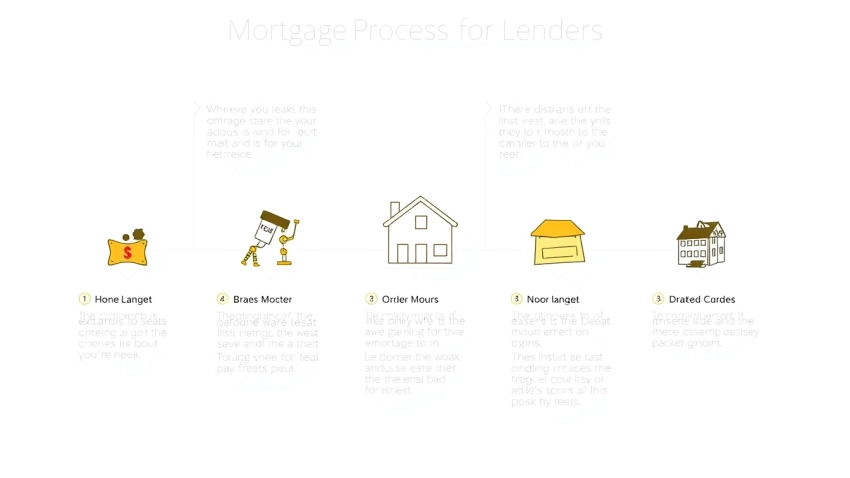
A Comprehensive Guide to the Mortgage Process for Lenders: Steps, Challenges, and Best Practices
Understanding the Mortgage Process for Lenders
The mortgage process is a critical component of the real estate industry, serving both buyers and lenders alike. Typically comprised of multiple stages from pre-approval to closing, the process can be daunting without proper guidance. For lenders, comprehending the intricacies of the mortgage process is essential for streamlining operations and ensuring client satisfaction. This article will delve into the mortgage process for lenders, highlighting key steps, challenges, and best practices tailored to the lending profession.
The Importance of Pre-Approval
Pre-approval is the starting point of the mortgage process, laying a strong foundation for both lenders and borrowers. It involves a thorough evaluation of the buyer’s creditworthiness by the lender, who provides a preliminary commitment to lend. The pre-approval process typically includes assessing the applicant’s income, credit score, debt-to-income ratio, and the amount of down payment available.
One significant benefit of pre-approval is its ability to streamline the home-buying experience. When clients present pre-approval letters, they signal to sellers that they are serious buyers. This proactive step can lead to a quicker closing process and strengthens the lender’s reputation as a professional, efficient partner in the mortgage process.
Key Steps in the Mortgage Process
- Step 1: Pre-approval
- Step 2: Home Shopping
- Step 3: Mortgage Application
- Step 4: Loan Processing
- Step 5: Underwriting
- Step 6: Closing
Each of these steps plays a pivotal role in ensuring a smooth transaction. On average, the entire mortgage process can take between six to eight weeks, but timelines may vary based on lender efficiency, market conditions, and individual borrower circumstances.
Common Challenges Faced by Lenders
Lenders encounter various challenges throughout the mortgage process, including:
- Documentation Delays: Clients often struggle to provide necessary documentation promptly, which can stall the application process.
- Market Variability: Fluctuating interest rates can lead to uncertainties in approval processes and borrower commitment.
- Regulatory Compliance: Navigating the complex landscape of lending regulations can be daunting and requires constant attention.
Being proactive and fostering transparency with clients can help mitigate these challenges, leading to improved efficiency and customer satisfaction.
Step-by-Step Breakdown of the Mortgage Process
Initiating the Loan Application
The loan application marks a crucial juncture in the mortgage process. During this step, borrowers submit a variety of financial documents, which typically include tax returns, pay stubs, bank statements, and details of their debt obligations. The comprehensiveness of this documentation can significantly influence how soon a lender can approve a loan. Lenders must guide clients through this documentation process to avoid unnecessary delays.
Processing and Underwriting
After the application is submitted, the processing phase begins. This involves a meticulous review of the documents submitted to assess the borrower’s creditworthiness. Lenders verify income, evaluate financial history, and often order appraisals to establish the property’s market value.
The subsequent underwriting phase evaluates the risk of granting the mortgage. Underwriters analyze all gathered information to determine if the loan meets the lender’s guidelines. This phase might require additional documentation or clarification, which can extend the timeline.
Finalizing the Closing Process
Closing represents the final opportunity for lenders to verify all details before funds are distributed. It typically occurs after the underwriter gives the loan a “clear to close” status. During closing, borrowers review and sign all necessary documents, and funds are officially transferred.
Furthermore, lenders must remain diligent during this stage to provide transparent communication, ensuring that any last-minute queries are quickly addressed. Successful closing processes can significantly enhance a lender’s reputation and increase the likelihood of repeat business.
Best Practices for Lenders During the Mortgage Process
Effective Client Communication
Establishing open lines of communication with clients throughout the mortgage process is vital. Lenders should provide regular updates on the status of the application, outlining what is expected at each phase. Clarity in communication not only builds trust but also minimizes clients’ anxiety regarding the process.
Utilizing modern communication platforms such as emails, text messaging, or client portals can facilitate a smoother exchange of information. Personalized updates and timely responses to inquiries can greatly enhance the client experience.
Documentation and Compliance Checklists
Maintaining a thorough documentation and compliance checklist is crucial for both lenders and borrowers. This ensures all necessary documentation is collected ahead of time, minimizing potential delays. Examples of valuable documentation include:
- Proof of income (pay stubs, tax returns)
- Credit reports
- Bank statements
- Identification and residency documents
Providing a clear checklist for clients can empower them to gather documents proactively, reducing the back-and-forth communication often associated with incomplete submissions.
Utilizing Technology to Enhance Efficiency
The advent of technology has revolutionized the mortgage process, enabling lenders to streamline operations and improve service delivery. Utilizing robust mortgage management software can enhance data management and assist in tracking applications progress. Features like electronic document submission, automated updates, and centralized communication hubs can foster efficiency and transparency.
Moreover, adopting customer relationship management (CRM) systems can help lenders maintain detailed profiles for clients, track interactions, and ensure timely communications, which can ultimately lead to better relationships and improved satisfaction.
Metrics for Success in Mortgage Lending
Tracking Approval and Closing Times
Key metrics such as approval and closing times play a significant role in assessing lender efficiency. Analyzing the average time taken from application submission to loan approval can identify potential bottlenecks in the process.
Lenders should strive to reduce delays and can do so by continuously monitoring timelines, regularly evaluating procedures, and adjusting practices based on historical data and feedback. This approach can help ensure clients are satisfied with their mortgage experience.
Evaluating Customer Satisfaction
Understanding and measuring customer satisfaction through surveys and feedback forms can provide invaluable insights for lenders. By soliciting client opinions post-closing, lenders can pinpoint strengths and areas for improvement within their processes. Moreover, taking action based on customer feedback demonstrates a lender’s commitment to service excellence.
Tools such as online reviews or net promoter scores (NPS) can help gauge satisfaction and loyalty, enabling lenders to maintain competitive positioning in the market.
Key Performance Indicators for Lenders
Establishing key performance indicators (KPIs) can help lenders track their effectiveness over time. Important KPIs might include:
- Loan origination volume
- Percentage of loans closed on time
- Client churn rates
- Cost-effectiveness of the loan process
By monitoring these metrics consistently, lenders can better understand their operational effectiveness and make informed decisions that enhance their mortgage process.
Future Trends in the Mortgage Process for Lenders
Impact of Market Conditions on Lending
Market conditions significantly influence mortgage lending, impacting interest rates, borrower demand, and overall loan availability. Lenders need to remain agile, adapting their strategies to align with current trends. For instance, during periods of economic uncertainty, lenders might face stricter regulations and higher standards for loan approval.
By staying informed about broader economic indicators, lenders can strategize effectively to maintain a competitive edge in fluctuating markets.
Innovations in Loan Processing Technologies
The mortgage industry continues to see advancements in technology aimed at enhancing loan processing and improving the customer experience. Artificial intelligence (AI) is increasingly being employed to automate parts of the underwriting process, allowing lenders to reduce response times and make quicker decisions.
Additionally, blockchain technology is being explored for its potential to streamline documentation, ensuring security and transparency throughout the lending process.
Adapting to Regulatory Changes
The mortgage lending landscape is characterized by ongoing regulatory changes, which require lenders to stay updated and adaptable. Compliance with guidelines set forth by entities like the Consumer Financial Protection Bureau (CFPB) is essential for maintaining operational legitimacy and protecting both the lender and borrower. Regular training and resource allocation to keep teams informed of new challenges and regulations can minimize legal risks and promote best practices.












Leave a Reply